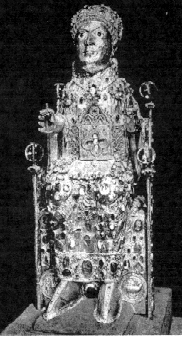
Chapter Two
SAINT FOY
286 A.D. Agen and Conques,
France
Hername was FIDES which, in the French language means Faith. She was only twelve years old the day the soldiers came to her village. They tortured her and later killed her but what she did that day and her name will be remembered for as long as history is read by man.
It was the year 286AD. MAXIMIAN (MARCUS AURELIUS VALERIUS MAXIMIANUS HERCULIUS) was the emperor of Rome. In addition to the chaos and terror he inflicted on all those in the kingdom who claimed to be Christians, this mad-man decreed that all Roman subjects were to worship him, for HE WAS A GOD.
One fateful day in the little town of Agen in the Roman province of Aquitania in France, the Roman soldiers came demanding that the people worship an image of MAXIMIAN. One Christian refused. It was FIDES.
Because of her stubborn disobedience, the soldiers stripped her and tied her to a griddle which they stretched over a bonfire. Legend says an attendant angel saw FIDES' plight and sent down a thick cloud to cover her nakedness. This same cloud dampened the fire so the Roman officer in charge ordered her dragged to an executioner who chopped off her head.
When the soldiers had gone, pious hands collected her body and head and hid them for safe keeping. Eventually, out of respect for her courage, her remains were placed in a handsome sepulcher in the Agen monastery.
Pilgrims began to come from great distances to behold the sepulcher and marvel at the faith of a twelve-year-old girl. The church decreed her a Saint, Saint FIDES. Legend say miraculous cures began to take place at the monastery and soon the story of Saint FIDES was known throughout all Western Christendom in those early middle ages.
A hundred miles or so to the northeast of Agen, perched on a cliff side in a forested wilderness, stood another monastery called Conques. Conques was to play an important role in the history of Saint FIDES.
Conques was built by a Frankish nobleman named DADON. He was a brutal man even by the standards of his time. Late in his life DADON was overcome by shame and remorse for the way he had lived. He became a hermit and lived on roots and berries. He punished himself by lacerating his own flesh.
The King of Aquitania, LOUIS the Pious, son of the great CHARLEMAGNE, heard about DADON and one day came to pray with the hermit. The King was impressed with DADON and when he left he gave DADON money to build a monastery on the site of his rude dwelling.
DADON scooped away tons of dirt and rock from the mountainside to form a shell-shaped ledge and there he built his monastery. On his return the King was pleased and named the site Conques, a word which comes from the Latin concha meaning shell.
The monks who later came to live at Conques had powerful patrons but the monastery did not enjoy the fame the monks thought it should. Few pilgrims were willing to make the dangerous journey through the rugged ravines and mountains to reach Conques; there was little in the whole area that would make it a popular place to visit.
The whole region was depressed and was the poorest in natural resources in all of France. It was always that way before and was to remain that way until an unlikely product of the area called Roquefort cheese became popular in the 1800s.
The monks of Conques reasoned they needed something to attract attention, something both physical and sacred. Something that manifested holiness. They hatched a plan.
These scheming brothers sent a young, smooth-talking monk named ARVISCUS to join the monastery at Agen. ARIVISCUS stayed at Agen for ten years and so gained the confidence of his superiors with his piety and zeal they made him the guardian of their most prized treasure, the tomb of Saint FIDES.
By that time Saint FIDES' name had been Gallicized. It was changed to FOY or FOI. The young saint had become known as Saint FOY.
One night when all the others
were asleep or at prayer, so the story goes, ARVISCUS broke open the tomb,
scooped up the bones of the Saint FOY, and fled over the hills back to
Conques.

The monks of Conques were proud of their plan to steal Saint FOY. They wrote many accounts of it in both verse and prose which they called THE FURTIVE TRANSLATION OF THE HOLY RELICS.
They reasoned in their hardheaded, medieval way that their plan was an act of piety. They claimed that if Saint FOY did not want her bones removed from Agen, she could have stopped ARIVISCUS in his tracks.
With Saint FOY's bones on display
miracles began to happen at Conques. Thousands of pilgrims journeyed to
the monastery, many of them bringing rich gifts for the Saint. The monks
decided Saint FOY's bones needed to be properly housed, so they crafted
a 33 inch statue called the MAJESTY OF SAINT FOY.

RELIQUARY STATUE OF
SAINTE FOY
ABBEY TREASURY- CONQUES
983-1013
This relic was an important religious element and a reliquary statue might be the most valuable or sacred object in a church. This gold and jeweled statue of Sainte Foy, thirty-three and a half inches high, attests to the saint's value to the congregation. The level of craftsmanship is very high.
This extraordinary object still exists. It is made of wood, encased in gold, sparkling with a profusion of jewels. Stiff, oddly shaped and oddly proportioned, it has great staring eyes of blue-black enamel which are totally hypnotic to the pilgrims who come to contemplate it.
The MAJESTY OF SAINT FOY and many other treasures collected over the centuries by the monastery are now kept in glass with electronic burglar alarms.
Today, a deep sleep has fallen on the ancient shrine. Conques is a lovely little village suspended in time, a genuine relic of ancient days. Like most remote villages in France, it is inhabited by a handful of elderly and retired people. The monastic community which once numbered more than a thousand has shrunk to three brothers of the Order of the Premontres. These monks guide bus loads of tourist through the dark underground room where Saint FOY resides.
The record of Saint FOY is
one of the very first references in recorded history where the name FOY
appears. It is the story of a twelve-year-old girl called faith
who was martyred by Roman soldiers in 286AD and because of that became
a Saint; SAINT FOY.
Submitted by Dick Miller
December, 1998
If you have a question, can add any information, or find a broken link please contact:
Trisha Carden

Copyright Information
| Much of the information published here is copyrighted by the various
researchers listed on our contributor
page. To obtain permission to use this information please contact the
researchers individually. This site is not meant for use for commercial
purposes.
|